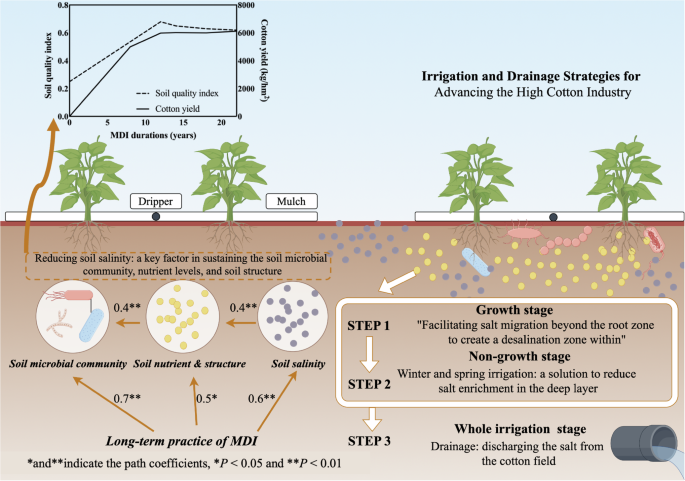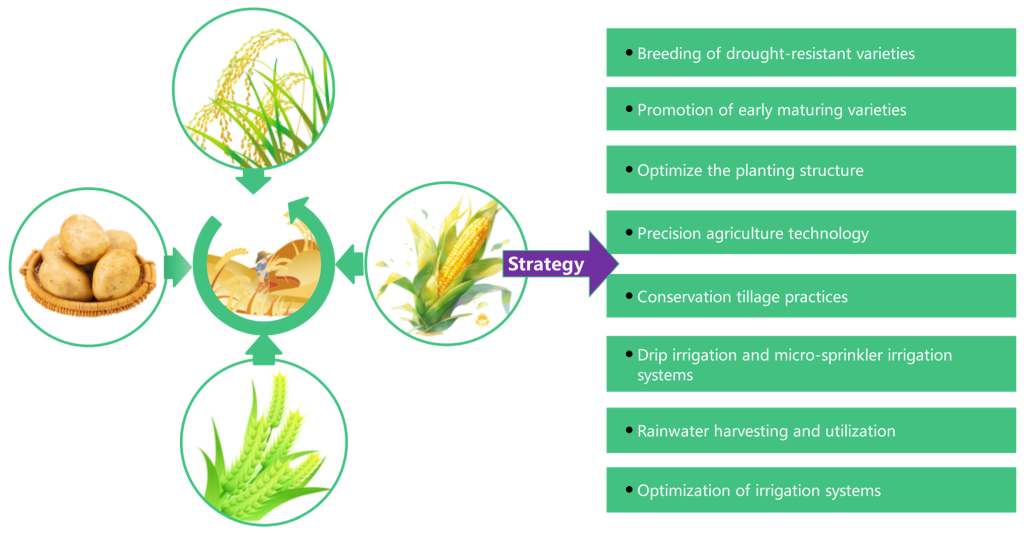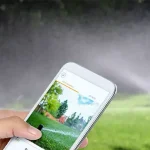Imagine transforming a barren landscape into a lush, thriving oasis. It sounds like a dream, doesn’t it?
Yet, for those living in arid regions, this dream can become a reality. You might be wondering how. The answer lies in efficient irrigation methods. These techniques are not just about watering plants; they are about maximizing every drop of water in a region where it’s scarce.
Why should you care about this? Efficient irrigation can mean the difference between struggling with parched soil and enjoying a flourishing garden or farm. It’s about sustainability, saving resources, and ensuring the future of agriculture in dry areas. By mastering these methods, you can play a crucial role in combating desertification and promoting environmental well-being. Curious to learn how you can make a real difference in your environment? Keep reading to discover innovative solutions that can help you turn dry lands into fertile grounds.

Drip Irrigation Systems
Drip irrigation systems offer precise water delivery directly to plant roots, conserving resources in arid regions. This method reduces evaporation and runoff, ensuring efficient use of water for crops and landscapes. Ideal for dry climates, drip irrigation promotes healthy plant growth and maximizes water efficiency.
Drip irrigation systems are a game-changer for farming in arid regions. These systems deliver water directly to the roots of plants, minimizing waste and maximizing efficiency. They are not just beneficial for large-scale farms but can also be adapted for home gardens, ensuring that every drop counts.What Is Drip Irrigation?
Drip irrigation is a method where water drips slowly to the roots of plants through a network of valves, pipes, tubing, and emitters. This method conserves water and nutrients by allowing water to drip slowly to the roots of plants. You can easily tailor it to meet the specific needs of different plants, ensuring they get just the right amount of hydration.Advantages Of Drip Irrigation
This system significantly reduces water wastage by delivering water directly to the plant roots. It prevents soil erosion and reduces weed growth, as water is only supplied where needed. Furthermore, it helps in maintaining the ideal moisture level in the soil, promoting healthy plant growth.Setting Up A Drip Irrigation System
Setting up a drip irrigation system might seem daunting, but it’s straightforward once you know the basics. Start by planning your layout and measuring the area you want to irrigate. Purchase quality components like tubing, emitters, and connectors that suit your garden’s needs.Maintenance Tips For Drip Irrigation
Regular maintenance of your drip irrigation system is essential for its longevity. Check for clogs in the emitters and clean them to ensure even water distribution. Inspect the tubing for leaks or cracks, and replace damaged parts promptly to keep the system efficient.Cost Considerations And Savings
Initial setup costs for drip irrigation can be higher than traditional methods. However, the savings in water bills and increased crop yield can quickly offset the expenses. Think about the long-term benefits and the positive impact on your water conservation efforts. Have you tried a drip irrigation system in your garden or farm? What’s holding you back from making the switch?
Rainwater Harvesting Techniques
Efficient irrigation in arid regions benefits from rainwater harvesting techniques. Collecting rainwater provides a sustainable water source. These methods support agriculture by optimizing water use and reducing wastage.
Rainwater harvesting techniques offer a smart solution for arid regions, where water is a precious resource. These methods not only help conserve water but also ensure sustainable agricultural practices. Imagine having a garden that thrives even in the driest conditions. With rainwater harvesting, this can become a reality.Understanding The Basics Of Rainwater Harvesting
Rainwater harvesting is all about collecting and storing rainwater for future use. It’s a simple yet effective way to make the most of the limited rainfall in arid areas. You can start by installing a system to catch rainwater from your roof. This water can then be stored in tanks for irrigation or other household needs.Different Types Of Rainwater Harvesting Systems
There are several systems you can consider. Surface runoff harvesting involves collecting rainwater that flows over the land. Rooftop rainwater harvesting is another popular method, where water is directed from roofs into storage tanks. These systems can be customized to suit your needs and the local environment.Materials You Need To Get Started
Setting up a rainwater harvesting system doesn’t require expensive materials. Basic items include gutters, downspouts, and storage tanks. You might also need a simple filtration system to remove debris from the water. Most of these items are readily available and easy to install.Benefits Of Rainwater Harvesting
Harvesting rainwater can reduce your dependency on other water sources. It helps conserve groundwater and reduces soil erosion. Also, using rainwater for irrigation can improve soil health over time. The benefits are numerous, making it a worthwhile investment for anyone in arid regions.Overcoming Common Challenges
You might face some challenges when setting up a rainwater harvesting system. Leaks in the system can lead to water loss. Regular maintenance can help prevent this. Consider installing a first flush system to remove the initial dirty water flow during rains.Practical Tips For Maximizing Efficiency
To get the most out of your rainwater harvesting system, check for leaks and clean gutters regularly. Ensure your storage tanks are covered to prevent contamination. Think about using drip irrigation systems to efficiently distribute stored rainwater to your plants.Is Rainwater Harvesting Right For You?
Ask yourself: do you want to save water and money? Rainwater harvesting could be the answer. It’s an eco-friendly solution that can make a big difference in water-scarce areas. Consider how these methods could fit into your lifestyle and community. Implementing rainwater harvesting techniques can transform the way you manage water in arid regions. By taking small steps, you can make a lasting impact on the environment and your wallet.Solar-powered Irrigation Pumps
Solar-powered irrigation pumps offer a sustainable solution for arid regions. These pumps use sunlight to draw water for crops. This method helps farmers save on energy costs. It also reduces reliance on fossil fuels. Solar pumps work efficiently in remote areas. They operate without an electric grid.
How Do Solar-powered Irrigation Pumps Work?
Solar panels capture sunlight and convert it into electricity. This electricity powers the pump to draw water from sources. The water then irrigates the fields. The process is clean and eco-friendly. It reduces carbon footprints significantly.
Benefits Of Using Solar-powered Pumps
Solar pumps help save money on energy bills. They require less maintenance. This ensures smooth operation over long periods. Farmers enjoy a steady water supply. This improves crop yields and boosts income.
Installation And Maintenance
Installing solar pumps is straightforward. Technicians set up the panels and connect them to the pump. Regular checks ensure optimal performance. Cleaning the panels enhances efficiency. This involves removing dust and debris.
Challenges And Solutions
Cloudy weather can affect solar pump performance. Batteries store excess energy for such days. High initial costs may deter some farmers. Government subsidies can help offset expenses. Training programs teach farmers about solar technology.

Smart Irrigation Technologies
Smart irrigation technologies are transforming how water is managed in arid regions. These methods optimize water use, ensuring plants receive adequate hydration without wastage. In areas where water is scarce, smart systems are vital for sustainable agriculture. Let’s explore how these technologies enhance irrigation efficiency.
Remote Sensing And Monitoring
Remote sensing tools gather real-time data on soil moisture and weather conditions. Sensors placed in fields transmit information to farmers. This allows them to adjust watering schedules based on accurate data. Reducing water waste and improving crop yield becomes easier.
Automated Sprinkler Systems
Automated sprinklers turn on and off at preset times. They apply precise amounts of water directly to plants. This method minimizes evaporation and runoff, saving water. Farmers can program these systems according to crop needs and local weather patterns.
Drip irrigation delivers water directly to plant roots. It uses a network of tubes and emitters. Water drips slowly, minimizing evaporation. This system is ideal for conserving water in dry areas. It ensures plants receive just the right amount of moisture.
Weather-based Controllers
Weather-based controllers adjust irrigation based on local forecasts. They use historical and current weather data. This helps determine optimal watering times. By aligning irrigation with weather patterns, these controllers prevent water wastage.
Mobile Apps For Irrigation Management
Mobile apps offer remote control over irrigation systems. Users can monitor and adjust settings from anywhere. These apps provide alerts on system performance and weather changes. This ensures efficient water use and timely adjustments.
Smart Water Valves
Smart water valves regulate flow and pressure automatically. They respond to soil moisture levels and weather data. By doing so, they prevent overwatering and reduce wastage. These valves are crucial in maintaining optimal water distribution.
Conclusion
Efficient irrigation transforms arid regions into productive lands. Farmers conserve water and boost crop yields. Drip irrigation is cost-effective and reduces waste. Sprinklers ensure even water distribution. These methods support sustainable agriculture in dry areas. Technology helps monitor soil moisture levels.
Farmers adapt to climate changes with smart solutions. Communities thrive as resources are used wisely. Invest in these practices for a greener future. Arid regions can flourish with proper irrigation. Everyone benefits from sustainable farming practices. Water is life’s cornerstone; let’s use it wisely.



